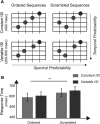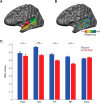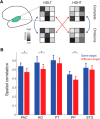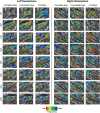Mapping Frequency-Specific Tone Predictions in the Human Auditory Cortex at High Spatial Resolution
- PMID: 29712781
- PMCID: PMC6596130
- DOI: 10.1523/JNEUROSCI.2205-17.2018
Mapping Frequency-Specific Tone Predictions in the Human Auditory Cortex at High Spatial Resolution
Abstract
Auditory inputs reaching our ears are often incomplete, but our brains nevertheless transform them into rich and complete perceptual phenomena such as meaningful conversations or pleasurable music. It has been hypothesized that our brains extract regularities in inputs, which enables us to predict the upcoming stimuli, leading to efficient sensory processing. However, it is unclear whether tone predictions are encoded with similar specificity as perceived signals. Here, we used high-field fMRI to investigate whether human auditory regions encode one of the most defining characteristics of auditory perception: the frequency of predicted tones. Two pairs of tone sequences were presented in ascending or descending directions, with the last tone omitted in half of the trials. Every pair of incomplete sequences contained identical sounds, but was associated with different expectations about the last tone (a high- or low-frequency target). This allowed us to disambiguate predictive signaling from sensory-driven processing. We recorded fMRI responses from eight female participants during passive listening to complete and incomplete sequences. Inspection of specificity and spatial patterns of responses revealed that target frequencies were encoded similarly during their presentations, as well as during omissions, suggesting frequency-specific encoding of predicted tones in the auditory cortex (AC). Importantly, frequency specificity of predictive signaling was observed already at the earliest levels of auditory cortical hierarchy: in the primary AC. Our findings provide evidence for content-specific predictive processing starting at the earliest cortical levels.SIGNIFICANCE STATEMENT Given the abundance of sensory information around us in any given moment, it has been proposed that our brain uses contextual information to prioritize and form predictions about incoming signals. However, there remains a surprising lack of understanding of the specificity and content of such prediction signaling; for example, whether a predicted tone is encoded with similar specificity as a perceived tone. Here, we show that early auditory regions encode the frequency of a tone that is predicted yet omitted. Our findings contribute to the understanding of how expectations shape sound processing in the human auditory cortex and provide further insights into how contextual information influences computations in neuronal circuits.
Keywords: auditory cortex; fMRI; predictions; predictive processing.
Copyright © 2018 the authors 0270-6474/18/384934-09$15.00/0.
Figures






References
Publication types
MeSH terms
LinkOut - more resources
Full Text Sources
Other Literature Sources
